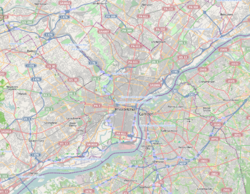Rittenhouse Square
|
Rittenhouse Square
|
|

(Autumn, 2010)
|
|
| Location | Philadelphia, Pennsylvania |
|---|---|
| Coordinates | 39°56′57.34″N 75°10′19.91″W / 39.9492611°N 75.1721972°WCoordinates: 39°56′57.34″N 75°10′19.91″W / 39.9492611°N 75.1721972°W |
| Built | 1683 |
| Architect | Thomas Holme; Paul Cret |
| MPS | Four Public Squares of Philadelphia TR |
| NRHP Reference # | 81000557 |
| Added to NRHP | September 14, 1981 |
Rittenhouse Square is one of the five original open-space parks planned by William Penn and his surveyor Thomas Holme during the late 17th century in central Philadelphia. The park is widely considered one of the finest urban public spaces in the United States.
The square cuts off 19th Street at Walnut Street and also at a half block above Manning Street. Its boundaries are 18th Street to the East, Walnut St. to the north, Rittenhouse Square West (a north-south boundary street), and Rittenhouse Square South (an east-west boundary street), making the park approximately two short blocks on each side.
Originally called Southwest Square, Rittenhouse Square was renamed in 1825 after David Rittenhouse, a descendant of the first paper-maker in Philadelphia, the German immigrant William Rittenhouse. William Rittenhouse's original paper-mill site is known as Rittenhousetown, located in the rural setting of Fairmount Park along Paper Mill Run. David Rittenhouse was a clockmaker and friend of the American Revolution, as well as a noted astronomer; a lunar crater is named after him.
In the early nineteenth century, as the city grew steadily from the Delaware River to the Schuylkill River, it became obvious that Rittenhouse Square would become a highly desirable address. James Harper, a merchant and brick manufacturer who had recently retired from the United States Congress, was the first person to build on the square, buying most of the north frontage, erecting a stately townhouse for himself at 1811 Walnut Street (c. 1840). Having thus set the patrician residential tone that would subsequently define the Square, he divided the rest of the land into generously proportioned building lots and sold them. Sold after the congressman's death, the Harper house became the home of the exclusive Rittenhouse Club, which added the present facade in c. 1901.
...
Wikipedia



